Roderick MacKinnon elected to U.S. National Academy of Sciences
click here for more on his research:
The Structure of Ion Channels

Roderick MacKinnon, M.D.
Professor Roderick MacKinnon, head of the Laboratory of Molecular Neurobiology and Biophysics and an investigator at the Howard Hughes Medical Institute, was elected to membership in the U.S. National Academy of Sciences (NAS) at the Academy’s 137th meeting on Tues., May 2. MacKinnon studies the functional and structural architecture of ion channel proteins, molecules that govern the electrical potential of membranes throughout nature, thereby generating nerve impulses and controlling muscle contraction, cardiac rhythm and hormone secretion.
The transfer of potassium ions across cell membranes has long been understood as an essential activity for many life-sustaining functions. The proper balance of these ions is essential for fundamental operations, such as the transmission of nerve impulses throughout the body and brain. But until MacKinnon captured an image of the channel, it was not well understood how the process actually worked.
“We are pleased that the Academy has chosen to recognize Rod for his outstanding contributions to our understanding of how the structure of ion channels relates to their function,” says President Arnold J. Levine, who was elected to the NAS in 1991.
In 1998, MacKinnon’s laboratory solved the structure of the potassium ion channel, and the three-dimensional image of the channel was published on the cover of Science magazine, which labeled the breakthrough one of the 10 biggest science stories of the year. MacKinnon is modest about the impact of his research, but other scientists strongly praised his work. “A remarkable accomplishment,” proclaimed Clay Armstrong, a professor in the Department of Physiology at the University of Pennsylvania School of Medicine who reviewed MacKinnon’s paper in the same issue of Science. “It is a dream come true for biophysicists.”
 MacKinnon calls the design of the potassium ion channel protein “elegant in its simplicity.” The balance of electrical forces and chemical bonds inside the protein not only sends potassium ions through the channel rapidly but also keeps out most other ions. MacKinnon’s research may play an important role in the development of drugs to deal with diseases ranging from diabetes to heart problems.
MacKinnon calls the design of the potassium ion channel protein “elegant in its simplicity.” The balance of electrical forces and chemical bonds inside the protein not only sends potassium ions through the channel rapidly but also keeps out most other ions. MacKinnon’s research may play an important role in the development of drugs to deal with diseases ranging from diabetes to heart problems.
The scientific community has recognized MacKinnon’s contributions and bestowed upon him some of its highest honors, including the 1999 Albert Lasker Basic Medical Research Award, the nation’s most distinguished honor for outstanding contributions to basic and clinical medical research; he shared the prize with Armstrong and Bertil Hille, a Rockefeller University alumnus who is a professor of physiology and biophysics at the University of Washington. MacKinnon is a member of Alpha Omega Alpha Medical Honors Society, a PEW scholar in the Biomedical Sciences and the recipient of the McKnight Scholars Award, the Biophysical Society Young Investigator Award, the McKnight Investigator Award, the W. Alden Spencer Award, the AAAS Newcomb Cleveland Prize and, most recently, the Lewis S. Rosenstiel Award for Distinguished Work in Basic Medical Science.


